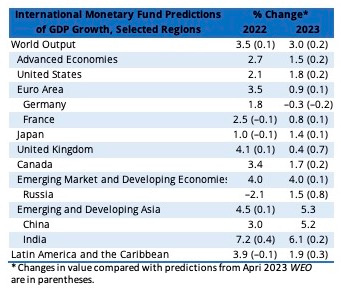Despite the May declaration by the World Health Organization (WHO) that COVID-19 is no longer a global health emergency and the resolution of many supply chain and shipping problems, global recovery from the COVID-19 pandemic and Russia’s invasion of Ukraine has slowed, according to the International Monetary Fund (IMF) in its July 2023 World Economic Outlook (WEO) Update: Near-Term Resilience, Persistent Challenges. The increases in central bank policy rates enacted to combat inflation have hindered economic activity, resulting in weak global growth. But growth estimates are slightly higher than predicted in April’s WEO on account of strength of the services sector in the first quarter of 2023. The most recent publication projects that global growth will drop from 3.5% in 2022 to 3.0% in 2023 and remain at 3.0% in 2024. Headline inflation is predicted to decline to from 8.7% in 2022 to 6.8% in 2023 and 5.2% in 2024.
Although the consumption of services increased early in 2023, other sectors, including manufacturing, experienced weakness. According to the IMF, the slowdown of industrial production in advanced economies has suppressed global trade and manufacturing in emerging markets. The report predicts that world trade growth will drop from 5.2% in 2022 to 2.0% in 2023 and then rise to 3.7% in 2024.
Corresponding to the decline in economic activity, oil prices are expected to decrease by about 21% in 2023 after increasing 39% in 2022. Lower commodity prices worldwide along with tightening monetary policy will drive the disinflation in 2023.

The IMF predicts 93% of the world’s advanced economies will experience declining growth of 1.5% in 2023 (down from 2.7%). In the US, an increase in consumption in 2023 is not anticipated to last, as savings have declined, and the Federal Reserve is expected to again raise interest rates. In Europe, strength in services and tourism has been offset by weakness in manufacturing in Germany. Pent-up demand in Japan, however, will result in growth of 1.4% in 2023, up from 1.0% in 2022.
In general, developing economies are expected to make a stronger showing, averaging 4.0% growth in 2023 and 4.1% in 2024. This growth will vary by region, however, with about 61% of the economies growing faster in 2023. Emerging and developing Asia is expected to grow 5.3% in 2023 and then dip to 5.0% in 2024. China will hit 5.2% in 2023 then drop to 4.5% in 2024 (stronger-than-expected net exports have helped to offset weakened investment resulting from the real estate downturn this year). Strong domestic investment in India has prompted a projection of 6.1% growth in 2023.
The analytical instruments industry continues to experience ups and downs of global economic recovery. The recovery of supply chains has improved prospects for orders and delivery of products. On the other hand, persistent inflation is a consideration in laboratories’ budgets, likely limiting their ability to purchase instruments. However, according to the US Energy Information Administration, US crude oil production is expected to reach record highs in 2023, which will drive increased demand for materials analysis and process analytical instrumentation products.